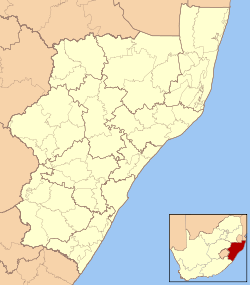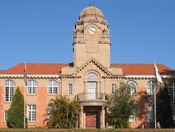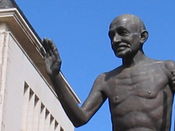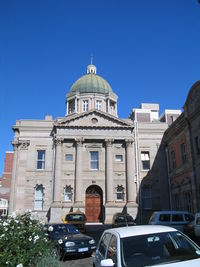Pietermaritzburg
| Pietermaritzburg umGungundlovu |
|
|---|---|
| — Provincial capital city — | |
|
|
|
| Nickname(s): PMB, Maritzburg | |
| Motto: The City of Choice | |
 Pietermaritzburg
|
|
| Coordinates: | |
| Country | |
| Province | KwaZulu-Natal |
| District | Umgungundlovu |
| Municipality | Msunduzi |
| Established | 1838 |
| Government | |
| - Mayor | Zanele Hlatshwayo |
| Area | |
| - Total | 649 km2 (250.6 sq mi) |
| Elevation | 596 m (1,955 ft) |
| Population (2001) | |
| - Total | 521,805 |
| - Density | 804/km2 (2,082.4/sq mi) |
| Time zone | SAST (UTC+2) |
| Area code(s) | 033 |
Pietermaritzburg is the capital and second largest city of the province of KwaZulu-Natal in South Africa. It was founded in 1838. Its "purist" Zulu name is umGungundlovu, and this is the name used for the district authority. Pietermaritzburg is popularly called Maritzburg in English and Zulu alike, and often informally abbreviated to PMB. It is a regionally important industrial hub, producing aluminium, timber and dairy products. It is home to many schools and tertiary education institutions, including a campus of the University of KwaZulu-Natal. It had a population of 228,549 in 1991;[1] the estimated current population in Msunduzi Local Municipality is between 500,000 and 600,000 (of which 25% to 30% are identified as Indians or Whites).
Contents |
History
The city was originally founded by the Voortrekkers, following the defeat of Dingane at the Battle of Blood River, and was the capital of the short-lived Boer republic, Natalia. Britain took over Pietermaritzburg in 1843 and it became the seat of the Natal Colony's administration with the first lieutenant-governor, Martin West, making it his home. Fort Napier, named after the governor of the Cape Colony, Sir George Thomas Napier, was built to house a garrison. In 1893 Natal received responsibility for their own government and an assembly building was built along with the city hall. In 1910, when the Union of South Africa was formed, Natal became a province of the union, and Pietermaritzburg remained the capital.
Name
There exist two interpretations about the origin of the city's name. One is that it was named after Piet Retief and Gert (Gerrit) Maritz, two famous Voortrekker leaders.[2] The other is that it was originally named after Piet Retief alone, since his full name was Pieter Mouriets Retief. In this interpretation the original name was "Pieter Mouriets Burg", later transliterated to the current name (Jenkins, 1971:11).
Retief was killed by Dingane, successor to Shaka, king of the Zulus. Maritz died in battle with the Zulus at Bloukranz, some hundreds of kilometres further North and so did not ever reach the Pietermaritzburg area. In 1938, however, the city announced officially that the second element Maritz should also honour Gert Maritz.
At the time of the rise of the Zulu Empire, the site that was to become Pietermaritzburg was called Umgungundlovu. This is popularly translated from the Zulu as "Place of the Elephant", although it could also be translated to mean "The elephant wins". Umgungundlovu is thus thought to be the site of some Zulu king's victory, since "Elephant" (Indlovu) is a name traditionally taken by the Zulu monarch. Legend has it that Shaka had his warriors hunt elephant there to sell the ivory to English traders at Durban (then called Port Natal). Today, the town is still called by its Voortrekker name, although the municipality it is part of bears the Zulu name.
Apartheid
During apartheid, the city was segregated into various sections. 90% of the Indian population was moved to the suburb of Northdale while most of its Zulu inhabitants were moved to the neighbouring township of Edendale.

The University
The University of Natal was founded in 1910[3] as the Natal University College and extended to Durban in 1922. The two campuses were incorporated into the University of Natal in March 1949. It became a major voice in the struggle against Apartheid, and was one of the first universities in the country to provide education to black students. This campus boasts association with a remarkable array of world-class academics and has famous alumni distributed throughout the world. It became the University of KwaZulu-Natal on 1 January 2004.

Mahatma Gandhi
Pietermaritzburg is also famous for an incident early in the life of Mahatma Gandhi. In May 1893, while Gandhi was on his way to Pretoria, a white man objected to Gandhi's presence in a first-class carriage, and he was ordered to move to the van compartment at the end of the train. Gandhi, who had a first-class ticket, refused, and was thrown off the train at Pietermaritzburg. Shivering through the winter night in the waiting room of the station, Gandhi made the momentous decision to stay on in South Africa and fight the racial discrimination against Indians there. Out of that struggle emerged his unique version of nonviolent resistance, Satyagraha. Today, a bronze statue of Gandhi stands in Church Street, in the city centre.
Other historical events
- The first newspaper in Natal, the Natal Witness (now known as The Witness), was published in 1846.
- The 46 hectare Botanic Gardens were created in 1872 by the Botanic Society of Natal.
- The city hall, which is the largest red-brick building in the Southern Hemisphere, was destroyed by fire in 1895, but was rebuilt in 1901.
- The British built an internment camp here during the Second Boer War to house Boer women and children.
- In 1962, Nelson Mandela was arrested in the nearby town of Howick to the north of Pietermaritzburg. The arrest marked the beginning of Nelson Mandela's 27 years of imprisonment. A small monument has been erected at the location of his arrest.
Capital status

Prior to the end of apartheid in 1994, Pietermaritzburg was the capital of Natal Province. Following the first post-apartheid elections in South Africa, as a result of which the Inkatha Freedom Party won a majority in the KwaZulu-Natal provincial government, Pietermaritzburg shared its status as capital of the (then newly-created) province of KwaZulu-Natal with Ulundi. Pietermaritzburg became the legislative capital of the new province, while Ulundi became the administrative capital. The IFP, being strongly Zulu nationalist, desired that Ulundi, the capital of the Zulu Kingdom at the time of its fall to the British in the Anglo-Zulu War, be the post-apartheid capital of the province. Ulundi had also been the capital of the bantustan KwaZulu, which makes up a portion of modern KwaZulu-Natal. However, Ulundi severely lacked the infrastructure to be an effective seat of government, and the African National Congress (ANC) and the Democratic Party, the two other strong political parties in the province, among others, called for Pietermaritzburg alone to be the capital. The debate came to an end when the ANC came to power in the province in 2004, and named Pietermaritzburg the sole capital of KwaZulu-Natal. This has resulted in the relocation of several government offices to Pietermaritzburg. This has generally been welcomed as a positive development for the region. Since 2004, progress such as the modernization of several buildings in the city centre and a proliferation of retail and housing developments in the suburbs are results of recent investment in the city by both the public and private sectors.
Transport
Pietermaritzburg is on the major road arterial between the Pretoria-Johannesburg-Witwatersrand conurbation and the harbour city of Durban, some 90 kilometres (55 miles) from Pietermaritzburg. The city is served by Pietermaritzburg-Oribi Airport. The airport provides domestic air services to Johannesburg and Cape Town. There is also a railway station in the city centre that connects directly to Durban and Johannesburg and indirectly to other major cities in South Africa.
Geography and climate
| Pietermaritzburg | ||||||||||||||||||||||||||||||||||||||||||||||||||||||||||||
|---|---|---|---|---|---|---|---|---|---|---|---|---|---|---|---|---|---|---|---|---|---|---|---|---|---|---|---|---|---|---|---|---|---|---|---|---|---|---|---|---|---|---|---|---|---|---|---|---|---|---|---|---|---|---|---|---|---|---|---|---|
| Climate chart () | ||||||||||||||||||||||||||||||||||||||||||||||||||||||||||||
|
||||||||||||||||||||||||||||||||||||||||||||||||||||||||||||
|
||||||||||||||||||||||||||||||||||||||||||||||||||||||||||||
| Climate data for Pietermaritzburg | |||||||||||||
|---|---|---|---|---|---|---|---|---|---|---|---|---|---|
| Month | Jan | Feb | Mar | Apr | May | Jun | Jul | Aug | Sep | Oct | Nov | Dec | Year |
| Source: South African Weather Service[4] | |||||||||||||
Sport
- The Comrades Marathon takes place annually in June between Pietermaritzburg and Durban. It has been run since 1921 and attracts thousands of entrants. The start of the race alternates between the two cities.
- The yearly Amashova is a 106km road cycling classic race held since 1986 which starts in Pietermartizburg and finishes in Durban. It is normally held in October.
- In January there is an annual canoe race, Dusi Canoe Marathon, from Pietermaritzburg to Durban. The route follows the Msunduzi River into the Mgeni River, through the Valley of a Thousand Hills into the Inanda Dam and from here to the mouth of the Mgeni River.
- The Midmar Mile is one of the largest open-water swimming events in the world; taking place at Midmar Dam, north of Pietermaritzburg in February every year, it attracts over 16,000 swimmers from around the world.
- The most prominent soccer club is Maritzburg United, which plays in the Premier Soccer League.
- The Pietermaritzburg Oval is considered one of the most picturesque cricket grounds in South Africa, and it hosted two matches during the 2003 Cricket World Cup.
- Pietermaritzburg cricket ground is notable as one of the two grounds used regularly for first-class cricket that have a tree within the boundary (the other is St Lawrence Ground in Canterbury, Kent).
- Between December 1953 and November 1981, Pietermaritzburg had an international standard motor racing circuit located on the outskirts of the city. The Roy Hesketh circuit measured 1.803 miles (2.902 km). The circuit was named after South African driver Roy Hesketh. During its period of operation it hosted rounds of the South African National Drivers Championship, the Springbok Series[5][6][7] and national Formula Atlantic races. The circuit was also like a second home to Mike Hailwood. The track was famous for hosting the Easter races as well - a festival of racing over three days. The expansion of the town of Pietermaritzburg eventually led to the redevelopment of the site as a residential and business zone after racing ceased at the end of 1981. The section from Henry's Knee to the top of Beacon still exists, and is undergoing protection from further development as an important piece of Pietermaritzburg's history.
- In 2010 the Bmx Racing Worlds they are going to take place in the city of Pietermaritzburg from July 15 to August 1.
Educational institutions
Pietermaritzburg is served by a number of schools and tertiary institutions. The University of KwaZulu-Natal is the largest educational institution in the city.
Educational Institutions of Pietermaritzburg
Famous residents
- Brendon Dedekind, swimmer (b. February 14, 1976)
- Bessie Head, writer, was born in Pietermaritzburg in 1937.
- Charles Llewellyn, cricketer (b. September 29, 1876). Holds the distinction of being the first non-White Test cricketer for South Africa.
- Tom Sharpe, novelist, who described the city "half the size of a New York cemetery and twice as dead".
- Cuan McCarthy, fast-bowling cricketer 1929-2000
- Phyllis McCarthy, noted authority and breeder of Rhodesian Ridgebacks
- Jonathan Handley, singer-songwriter (b. June 5, 1954), originally from Springs, founder of 'The Radio Rats' who in 1979 had a hit single 'ZX Dan' on Radio 5 (now 5FM).
- Shaun Morgan, lead singer of Seether, is a former resident of Pietermaritzburg and attended both Merchiston Preparatory School and Maritzburg College while he lived there.
- Dale Stewart, bassist of Seether, is also a former resident of Pietemaritzburg.
- Alan Paton, author of Cry the Beloved Country, was born in Pietermaritzburg.
- Kevin Pietersen, cricketer (b. June 27, 1980).
- Jonty Rhodes, cricketer (b. July 27, 1969)
- Kevin Volans, composer (b. July 6, 1949)
- Butch James, Springbok and Natal Sharks rugby player attended Maritzburg College from 1994-2000. He played for Colleges' 3rd team and is now the starting flyhalf for the Springboks.
- Greg Minnaar, three time Downhill World Cup champion (2001, 2005, 2008) for winning the Mountain Bike World Cup points series. He was also crowned Downhill World Champion in 2003, He also attended Carter High School.
- Jon Ekerold, World 350cc Motorcycle Champion
- Kork Ballington, World 250cc and 350cc Motorcycle Champion
- Alfie Cox, Multiple SA Endurance champion and Paris Dakar finisher
- Wade Nelson, World 250cc Kart Champion
- Graeme Pope-Ellis, 15 Time Duzi Canoe champion
- Stratford Johns, (b. September 22, 1925 - d. January 29, 2002) popular British stage, film and television actor. Left for Britain in 1948.
- Susan Schinkel, British television presenter.
- Judy Ditchfield, Actress
- Bryce Moon, (b. April 6, 1986) South African Football (soccer) player was born in Pietermaritzburg and played for Pirates (PMB) in his youth
- Brett Evans, (b. March 8, 1982) South African Football (soccer) player attended Merchiston Preparatory School and Maritzburg College and played for Maritzburg City as an amateur
Various
- Built in 1900, the City Hall was then the largest all-brick building in the southern hemisphere. It was declared a national monument in 1969.[8]
- At 14 metres high, the statue Pegasus adorning the entrance of the Golden Horse Casino is the largest statue of a horse in the world.[9][10]
Bibliography
- Ingram, J Forsyth (1898). The story of an African city. Pietermaritzburg: C. Coester. http://www.archive.org/details/storyofafricanci00ingrrich.
Notes
- ↑ 1991 Census
- ↑ Rhoodie, E. M.; Keith S. O. Beavon (1976). "Pietermaritzburg". In William D. Halsey. Collier's Encyclopedia. 19. New York: Macmillan Educational Corporation. p. 43.
- ↑ "History of the University of KwaZulu-Natal". http://www.ukzn.ac.za/aboutus/history.asp.
- ↑ 4.0 4.1 "Climate data for Pietermaritzburg". South African Weather Service. http://old.weathersa.co.za/Climat/Climstats/PietermaritzburgStats.jsp. Retrieved 7 March 2010.
- ↑ Springbok Series - Sportscar championship in South Africa, that was run usually during winter. Until 1963 was Springbok series for F1 cars. Championship ended in 1973 after two races due to the Middle East oil crisis and never was restarted again... WSPR-racing.com
- ↑ South African Springbok Trophy Series - South African endurance sports car championship. It was usually held during the winter when the main season had been finished. Until 1963 the Springbok series was destined for F1 cars before it switched to mixed sports car and touring car field. The main race of the series was well known Kyalami 9 Hours, which enjoyed good international competition. Also many of the other races were well supported. Sports cars were limited to two litres in 1970 but three litre cars were still allowed in the main 9 hour event, so even factory Ferrari took the challenge and won in Kyalami three consecutive times during 1970-72 period facing opposition of Porsche 917 and other great machinery of the time. The championship ended up in 1973 after only two races due to the Middle East oil crisis and was never restarted again. The Kyalami event was then shortened to 6 hours and became part of the World Manufacturers Championship, but only for a single season. It then continued under various rules sets and distances over the next decade appearing two more times in the World Sports Car Championship calendar (1983 and 1984 - but the latter was a complete fiasco and it never returned in its full 1000 km distance, nor as part of the WSPC. Just a few shorter races were held for a few more years to come but 1985. WSRP.ic.cz
- ↑ IMCA-slotracing.com
- ↑ "Pietermaritzburg - Home Of Gandhi and The Comrades Marathon". Encounter South Africa. http://www.encounter.co.za/article/60.html. Retrieved 2007-01-01.
- ↑ "Pietermaritzburg Tourism". http://www.pmbtourism.co.za/aff/pmbtourism/about_us/default.htm. Retrieved 2007-01-01.
- ↑ "Golden Horse Casino Hotel". CyberCapeTown Greater Durban Area Accommodation Portal.. http://cybercapetown.com/GoldenHorse/. Retrieved 2007-01-01.
References
- Jenkins, G. 1971. A Century of History: the story of Potchefstroom. 2nd ed. AA Balkema. Cape Town. 120 p.
External links
|
|||||
|
||||||||||||||